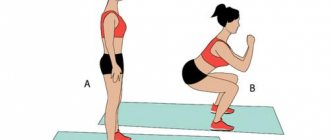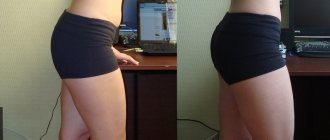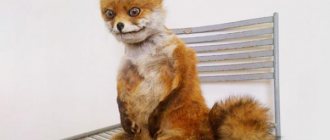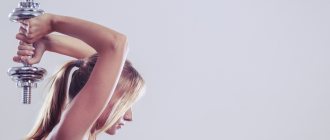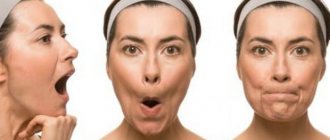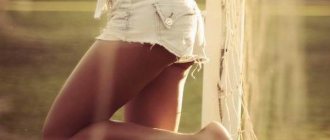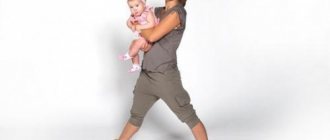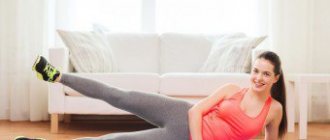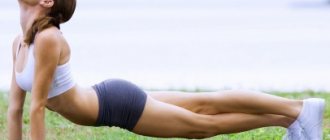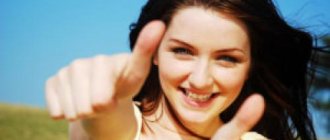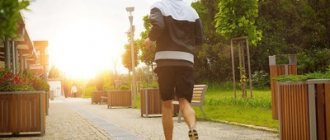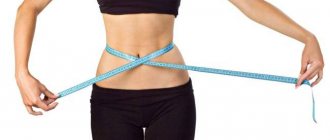How to straighten your legs: exercises to correct false, varus, valgus deformities
There are several types of leg curvature: false and true. False curvature is an aesthetic defect characterized by deformation of soft tissues: when the feet and knees are closed, the calves of the legs do not touch. True deformation is divided into two types: O-shaped and X-shaped. To straighten legs that have any of the described deformities, it is necessary to regularly perform a certain set of physical exercises. Before you start training, you need to consult a doctor who, based on x-rays, will confirm the type of curvature. Otherwise, instead of straight lower limbs, you can get a dangerous injury that will aggravate the original condition.
Types of true curvature and methods for determining them at home
True curvature is divided into two types:
O-shaped or varus
People with such bone deformities are said to have legs like wheels or like a football player. Wherever the discrepancy begins - from the level of the hip or the area below the knee, the shape of the legs will still end up looking like the letter “O”. The knees will “fall out” of the three ideal points of contact - they will not close with such a deformation.
X-shaped or valgus
In this case, the knees, on the contrary, close tightly, but the ankles cannot come together. As a result, the shape of the lower limbs resembles the letter “X” and such people are said to have “X” legs.
We offer a simple mini-check test:
- Stand straight in front of the mirror, bend one limb and observe the kneecap of the straight supporting leg. If it is displaced inward, you have an O-shaped deformity; if it is displaced outward, you have an X-shaped deformity.
- Place your hands on your belt and do a simple squat at a slow pace. Watch your knees: with an O-shaped curvature, they tend to the sides, with an X-shaped curvature, they want to connect, if the legs are straight, they bend parallel to the feet.
An x-ray will help to finally put an end to this issue. She will not be deceived by false curvature - in the picture the axis of the leg, no matter what impression the disproportionately distributed muscles make, will be straight.
It must be said that distortion of the lower extremities is not only a problem of aesthetics. This can harm your legs and back. But today, almost any curvature can be straightened and leveled - it can be done independently or using special techniques.
Peculiarity! There are cases when valgus and varus refer to false curvature. As a result of age-related changes or injury to ligaments, joints that are not held together by them may become loose, and as a result, the knees may stop closing. It can be difficult to figure out on your own why the shape of your legs is distorted and to distinguish false curvature from true one.
Warm-up
In order to eliminate the risk of injury during training, you need to do a warm-up before it, which will help thoroughly warm up the muscles of the lower extremities. There is a universal set of exercises that allows you to prepare the leg muscles for the correction of O-shaped and X-shaped curvature.
- Take a standing position with your feet shoulder-width apart. The feet are parallel. The toes are raised so that the rest of the feet do not leave the floor. Then your toes need to be tucked. During the exercise, it is necessary to strain the leg muscles involved in this movement as much as possible.
- The person stands up, connects his heels, and spreads his toes to the sides. Then you need to slowly stand on your toes, tensing the muscles of your lower legs, thighs and feet. In this position, you need to slowly spread your heels and then bring them together.
- You need to sit on a chair with your legs slightly apart. The heels rest on the floor, and the feet rise towards themselves. The feet turn in different directions until slight pain appears in them.
- The starting position is similar to the previous one. Socks stretch out and touch the floor. The heels are spread out and brought together at a slow pace.
- Without changing position, you need to press your feet together, resting their outer arches on the floor. The feet roll from heels to toes and back.
- A person lies on his back and imitates fast cycling for 1 minute.
A woman should repeat each exercise 10 times, a man - 20.
How to quickly gain weight in your legs with self-training
The effect of these exercises will not take long to appear if you do not neglect certain rules:
- Do training several times a week. As your muscles become accustomed and form, you can increase their number to twice a day.
- Take your time and don't do too many sets at once. Everything is gradual.
- Don't neglect warming up and cooling down after training.
Any workout should begin with a warm-up. To do this, just warm up the muscles a little with your hands or walk around the room.
- What to do to make your legs thicker in the calf area. Stand against the wall, leaning your shoulder blades and buttocks. Rise up onto your toes and hold for ten seconds. Then lower yourself for ten seconds and rise again. You can walk around the room on your toes for a few minutes.
- Standing on one leg, straighten the other and try to raise it as high as possible, as if swinging upward. Repeat no more than ten times with each leg.
- Standing, feet together, arms extended forward or at the waist. Slowly squat down so that your heels do not leave the floor. Squats should be done at a slow pace for greater effectiveness, but no more than ten times. You can also do such squats, but with your feet shoulder-width apart or while squatting, spread your knees. As you get used to it, squat with weight in your hands (water bottle, dumbbells).
- A very effective exercise for strengthening the inner thigh muscles is squeezing a ball with your knees. If you don't have sports equipment, you can try using your hands to prevent your knees from closing. These muscle groups are also well trained by squats, when the legs are spread wide and the toes point as far as possible to the side.
- To strengthen the butt. Sitting on the floor without using your arms or legs, using only your gluteal muscles, try to move forward. You can train your butt while sitting on a chair, contracting and relaxing your gluteal muscles for a few seconds.
- The scissors exercise trains your legs well, but with maximum weights. For example, weights on the calves, heavy shoes.
- Jumping that imitates the jumping of a frog. The main thing is to jump as much as possible and lower yourself to the floor as much as possible, as if trying to touch the floor with your butt.
There are still a huge number of ways that supposedly will help you get beautiful legs in the shortest possible time. But the most effective and safest are physical activity and protein-enriched nutrition. Only through food, proper and regular exercise can you get better in your legs.
and butt for a long time (or forever) without harm to health and body.
If you are not overweight and your legs suddenly become fuller, you may simply be swelling. Whether it is swelling or not is very easy to find out. In the evening, pay attention to your socks, if you have marks on them from the elastic bands of your socks, this is swelling. You can also press on the bone with your finger. If after this a dimple appears on the leg, disappearing gradually, swelling occurs. Another sign is that putting on shoes is easy in the morning, but difficult in the evening.
With swelling, the legs actually become larger. To eliminate this problem, eliminate salty and fatty foods from your diet.
Diuretics help fight swelling, but before using them it is better to consult a doctor.
The second and most common cause of fullness in the legs is excess weight. The hips and bottom are the zone for bearing the fetus, so nature carefully protects these places, covering them with a layer of fat. When a woman gains excess weight, he often concentrates on.
Exercises to correct an O-shaped curvature
If a person’s legs are positioned in the letter O, it is necessary to skate skiing, on skates. Regular body ballet classes and swimming can improve the condition of your legs with a wheel. In medicine, such a curvature of the lower extremities is called varus; to correct it, many doctors and fitness trainers recommend performing the following set of exercises:
- alternate walking on the heels, inner arches of the feet;
- walking up the steps using your toes;
- squats with knees brought together or moving towards each other, the back remains straight during movement;
- alternate swings of legs to the sides from a standing position;
- lifting straight legs from the position: lying on your side;
- abduction and extension of the legs in the position: lying on the back;
- landing on a transverse twine.
All of the listed exercises are performed in three approaches, each of which contains 15–20 repetitions.
In addition to the described complex, there are other exercises that will help overcome O-shaped curvature of the lower extremities.
- Performing the scissors exercise. At the same time, the person sits down and rests his hands on the floor behind his back.
- Exercise “scissors” from the starting position: lying on your back. Horizontal and vertical movements of the legs are performed.
- The man kneels down and places his hands on his belt. The knees are brought together, the feet are apart and directed in different directions, the toes are extended. Then you should slowly sit on the floor, and then return to the starting position.
- “Bicycle” exercise, which can be performed from positions: sitting on a chair or lying on your back.
- Formation of abdominal muscles. The person lies on his back and fixes an isotonic ring between his legs. The torso rises so that the person assumes a sitting position.
- The person stands up and places his feet shoulder-width apart. The knees are brought together and spread apart so that the feet do not leave the floor.
The listed exercises can be used to eliminate the problem of O-shaped lower extremities not only in women, but also in men.
O-shaped legs
O-shaped legs
– a pathological condition in which the legs are bent at an angle that is open inwards.
Typically, this pathology occurs due to an arched or, less commonly, angular curvature of the legs, resulting from congenital malformations or diseases characterized by a decrease in the strength of bone tissue.
Accompanied by compensatory deformation of other parts of the lower extremities, especially the feet. The diagnosis is made based on examination, radiography, CT, MRI and other studies. Treatment can be either conservative or surgical.
M21.1
Varus deformity, not elsewhere classified
O-shaped legs are a varus deformity of the limbs, in which a person standing with his legs together does not touch his knees, but is at some distance from each other.
In this case, a gap is formed between the legs, resembling the letter “O”. It is a fairly widespread pathology. Normally observed in children under 24 months of age.
If the O-shaped alignment persists at an older age, conservative or surgical correction is necessary.
Although varus curvature of the legs is considered a relatively favorable deformity compared with valgus curvature, this pathology also entails negative consequences. With varus curvature of the legs, the feet compensatory “go” into a vicious position, which leads to secondary flatfoot.
All of the above indicates the high relevance of the problem of O-shaped legs in modern traumatology, orthopedics and pediatrics.
O-shaped legs
Normally, all newborns have a slight arched curvature of the legs (up to 20 degrees), due to the intrauterine position of the fetus. In this case, the child’s legs are symmetrical, but the shape and position of the feet may be asymmetrical.
By the age of 2, the O-shaped deformity disappears and is gradually replaced by an X-shaped (valgus) one. A slight valgus curvature of the legs (up to 15 degrees) persists for up to 3 years, and then begins to decrease and by the age of 8 does not exceed 7-9 degrees.
Subsequently, both the complete disappearance of the curvature and the preservation of a slight residual angle are possible.
Varus curvature, which persists at the age of 2 years and older, is the cause of abnormal development of the knee joints. The external condyle of the femur increases, the internal one decreases. The joint space becomes uneven - narrowed inside and widened outside.
The inner meniscus is compressed, the ligaments along the outer surface of the joint are stretched. Initially, the feet take a flat-varus position, their anterior sections and heels deviate inward. Subsequently, a compensatory flatvalgus deformity of the feet is formed.
In severe cases, the tibia rotates inward and the hips rotate outward. Flexion in the knee joints is limited. Gait disturbances and rapid fatigue when walking occur.
The cause of unilateral O-shaped deformity in infancy is usually congenital hypoplasia caused by neurofibromatosis or fibrocystic dysplasia of the tibia.
In contrast to physiological varus curvature, with this pathology, uneven deformation is observed (one lower leg is more curved than the other).
The outcome of congenital hypoplasia of the leg bones can be pseudarthrosis.
Traditionally, rickets ranks high on the list of causes of O-shaped legs. And although this pathology is quite rare in pediatrics these days, it can occur, so it should always be excluded during differential diagnosis.
It should be taken into account that rickets can develop in three periods of a child’s life: in utero (that is, congenital), at an early age and in adolescence. The cause of fetal rickets is vitamin D deficiency in the mother.
Currently, this pathology is detected mainly in economically disadvantaged countries.
Infantile rickets occurs after stopping breastfeeding. At this stage of development, the child’s body requires a large amount of vitamin D. If the baby does not receive this vitamin in sufficient quantities, his bones become insufficiently strong and gradually bend when walking. An O-shaped curvature of both the legs and hips is possible.
In some cases, an asymmetrical deformity is observed: varus curvature on one side is combined with valgus curvature on the other side. Anterior bending can also form - the so-called saber shins.
Moreover, in contrast to damage to the legs with syphilis, when the legs are bent only anteriorly, a combination of deformation in the lateral and anteroposterior directions is observed.
Another critical age at which the likelihood of developing rickets increases is the period of intensive growth in adolescents.
There is persistent late rickets, which, unlike the usual form of the disease, does not respond to treatment with standard doses of vitamin D. Persistent rickets develops due to genetic predisposition, chronic kidney disease and steatorrhea.
Intestinal rickets (rickets with steatorrhea) can occur with any type of long-term intestinal disorder. Occurs due to impaired absorption of fats, vitamins, phosphates and calcium.
Similar disorders can be detected in adults, but in the latter case it is not rickets, but osteomalacia. The cause of the development of renal rickets is chronic kidney diseases that interfere with the retention of phosphates and calcium in the blood serum.
With renal rickets, valgus deformity is most often observed, but an O-shaped curvature is also possible.
Another reason for the formation of O-shaped legs is Blount's disease (deforming osteochondrosis of the tibia).
With this disease, there is not an arched curvature, as with rickets, but an angular curvature of the leg with the apex of the deformity at the level of the proximal epiphysis.
At an early age (2-4 years), with Blount's disease, as a rule, bilateral curvature is detected; at an older age, only one lower leg may be curvature.
The curvature is caused by excessive growth of bone tissue with insufficient destruction. In this case, the newly formed bone does not have sufficient strength due to incomplete calcification.
It thickens and at the same time becomes soft, resulting in curvature and transverse fractures.
Depending on their age, an adult orthopedist and a pediatric orthopedic traumatologist can diagnose patients with O-shaped legs. The most important task when examining patients with O-shaped legs is to identify the underlying disease that caused the deformity.
When making a diagnosis, the clinical picture, features of the curvature, the age at which the first symptoms appeared, heredity and the condition of other organs and systems are taken into account. All patients with O-shaped legs are prescribed radiography of the legs.
If there is concomitant deformation of the upper limbs, an additional x-ray of the hips is performed; if compensatory changes in other parts of the limbs are suspected, x-rays of the hip joints and x-rays of the feet are performed.
To exclude rickets, the levels of alkaline phosphatase, phosphorus and calcium are studied in blood tests.
If persistent forms of rickets caused by kidney and gastrointestinal diseases are suspected, the patient is referred for consultation to a nephrologist and gastroenterologist.
To exclude Blount's disease and Paget's disease, radiographs are examined, and if necessary, MRI and CT scans of the legs are additionally prescribed. To identify hereditary predisposition, family history is studied in detail.
According to indications, treatment of the underlying disease is carried out.
It should be borne in mind that correction of O-shaped deformity without eliminating its causes may be ineffective and in some cases even leads to the progression of the curvature, the formation of false joints, etc.
In adults, only surgical correction of the shape of the legs is possible. Usually, for O-shaped legs, a corrective osteotomy is performed in combination with the application of an Ilizarov apparatus.
Incomplete osteotomy (dissection of the bone only along the inner surface) is used for true O-shaped curvature and a favorable distribution of the soft tissues of the lower leg from an aesthetic point of view. In other cases, a complete osteotomy is used.
Depending on the magnitude and nature of the deformation, both immediate and gradual elimination of the curvature is possible.
In the first case, the patient’s shins are immediately brought into the correct position; in the second, the relative position of the fragments is corrected by gradually “unscrewing” the nuts and increasing the distance between the rings on the inside. In the postoperative period, exercise therapy and physical therapy are prescribed. Usually it takes about 2 months to correct the shape of the legs, but with severe deformities this period may increase.
Source: https://www.KrasotaiMedicina.ru/diseases/traumatology/O-shaped-legs
Correction of X-shaped curvature
X-shaped curvature of the lower extremities is called valgus in medicine. To correct such a defect, you need to regularly swim, do yoga, ride a bike, or ride a horse. You can cope with this problem at home; to do this, you need to regularly perform the following exercises:
- walking on the outer arches of the feet;
- walking on your knees:
- side lunges;
- swing your legs with your toes pointed to the side.
You can supplement the presented complex with the following effective exercises.
- A man stands up and holds a ball between his knees. Squats are done so that the thighs and shins form an angle of 90 degrees.
- A standing position is assumed. The feet are placed shoulder-width apart, squats are performed, as if a person is sitting on a chair, but the pelvis should not be lowered below the knees.
- A sitting position is assumed with legs crossed “Turkish”. You should put pressure on your knees with your hands, trying to bring them closer together. Pressure is then applied to the knees, bringing them closer to the floor.
- A person lies on his stomach, connects his feet, spreads his knees in different directions.
The presented exercises allow you to solve the problem of positioning your legs in an X by working the muscles of the outer thighs.
Correcting a true curvature without surgery is a long process, so before starting training you need to get ready to work hard on your own body and not wait for quick results to appear.
Types of leg curvature (PHOTO)
The beauty of legs is a concept that everyone builds on personal aesthetic perception. Just beautiful, that's all, you say. But it turns out that ideal legs exist, and their shape is calculated mathematically.
They should reach a length of up to 55% of your height, and it is also necessary to maintain certain proportions between body height and the volume of the hips and ankles. But the main thing is the rule of a straight line : if you draw an imaginary straight line from the middle of the thigh through the closed knees and ankles, then three gaps will be visible along the smooth inner contour of the limb: from the crotch to the knee joints, under the closed knees to the calves and from the calf muscles to the ankles. In front of you are perfect legs. But not everyone has been blessed with such things by nature. Anthropometric cosmetology deals with the correction of such defects.
The legs of many men and women are characterized by curvature, varying in severity and divided into two types - false and true. What is it and what is their fundamental difference?
True
This curvature is the result of anatomical features or deformation of the skeletal bones of the femur and lower leg. The lower limbs seem to form an arc. The cause of true, that is, bone curvature, is most often hereditary genes or diseases suffered at a young age, for example, rickets, or metabolic disorders.
False
Such curvature is a disproportionate distribution of the soft tissues of the thigh and lower leg with a smooth, defect-free position of the skeletal bones. We can say that false curvature is the appearance of curvature in its real absence.
Elimination of false curvature
Since false curvature does not deform the bones, it can be dealt with using exercises aimed at working the muscles of the lower leg and calves. One of the most effective complexes for this is considered to be one that is based on the following exercises:
- squats on toes with dumbbells;
- walking on toes for long periods of time;
- walking quickly up the steps, resting on your toes;
- transferring the body onto socks with weights from a standing position.
All of the above exercises must be repeated until moderate pain appears in the calf muscles and lower leg. Once the pain begins to spread, you need to stop training. When the muscles become toned, the approaches need to be repeated.
Exercises against false curvature of the legs
The essence of all exercises against false curvature comes down to pumping up the calves, and on the Internet you will find hundreds of fancy exercises. We advise you to take one thing as a basis: something with which you can ensure muscle growth and correct your problem. The main thing is to do it correctly.
So, let's try to master the only effective exercise for adding volume to the calves - calf raises. “Well, I’ll definitely be able to get up on my toes,” you think, jumping up from your chair and starting to do lifts. Do not hurry. There are several nuances to this exercise.
- Repetitions. In many anti-curvature exercises you will see calls to do 50 reps or more on each set, but this tactic may not help increase muscle size. Reduce repetitions to 15-18 and do 3 such sets.
- Weight . Neither men nor women will have enough weight to pump up their muscles, no matter how much dumbbells and weights frighten the latter. 20 kg in the form of two dumbbells that you just need to hold in your hands is absolutely a lifting weight for the average woman, well, or you can use any calf machine. It is better for men to use exercise machines so as not to hold large weights in their hands, because it is not very convenient.
- Refusal . The calves are worked to failure, which means that the last repetition of each approach should be very difficult and accompanied by a barely tolerable burning sensation. Is it easy for you? Then increase the weight. After the approach, stretch your calves a little and rest until the burning stops completely.
- Stretching at the bottom. There is no point in doing calf raises on a flat surface, as the range of motion will be too small. Your calves need to be able to stretch, and to do that you need to have some headroom to go below horizontal. The machines always have a special support that will allow you to move your heel down, and if you are doing an exercise with free weights, stand on a step or step platform to ensure a reserve of movement.
- Knees . Don't stick your knees in if you don't want joint problems. This advice is especially relevant for men who lift heavy weights. Always keep your knees slightly bent or in a natural bend position. This way, the struggle for proportional calves will not result in an unpleasant injury.
- Leg positioning. Depending on the position of the legs, different parts of the calf muscle are included in the work. We are interested in its inner part, to work it out you will need to stand with your feet shoulder-width apart and turn your toes slightly outward.
Exercises for children
Doctors recommend correcting the problem of crooked lower limbs in a child under 7 years of age. This is due to the fact that at an older age the correction process will take much longer. In order to help a child straighten his legs, it is necessary to perform a certain set of exercises with him.
- Walking in a circle on your toes, on the inner and outer arch of the foot.
- Walking with a ball held between your knees.
- Take a lying position with your legs slightly apart. The feet should be turned inward. The toes curl. The feet turn so that their toes touch.
- The child gets on all fours, stretches one leg back and up. In this case, the toe should be stretched out as much as possible.
- The child lies on his stomach, his chin is placed on his hands, his legs are brought together. The legs simultaneously bend at the knees, the heels reach the gluteal muscles.
Wheel legs
From the birth of a child until he reaches adulthood, we are responsible for his health. Many young mothers sound the alarm about their baby's crooked legs.
Do not forget what position the baby is in the womb. Of course, ’s legs will not be perfectly straight. After three or four days they level out.
But to avoid problems with them in the future, you should:
- Breastfeed - you yourself should eat well, despite your weight gain.
- Artificial feeding - the right nutrition must be selected, exactly suitable for your baby.
- Monthly examination by a doctor, up to three months.
- All vaccinations are required.
- Long stays on walks in the summer. The child receives vitamin D from sunlight. Winter children, if there is a shortage of it, take it in drops.
- Daily water treatments with massage.
- Morning air baths.
- This type of care for your baby will protect you from unnecessary worries.
Development of the skeletal system in prematurely born babies
Most calcium enrichment in infants occurs in the third month of life. At this time, you should especially carefully monitor the baby’s proper nutrition. No one argues that mother's milk is the best protection against all diseases. But mothers whose children are bottle-fed should not be upset. A properly selected mixture is quite capable of replacing mom’s food.
It is not a fact that those born prematurely often suffer from rickets. Today, it is very rare to hear that a child has had a change in the skeletal system. If your doctor, during an examination, immediately identifies such a disease, run away from him.
Without a thorough examination, no professor can accurately determine whether a baby has rickets or not. Spend more time in the sun, feed the right mixtures and you will grow a healthy baby.
How to prevent your baby's legs from becoming crooked?
A human being born is already an individual. Do not try to demand that he perform actions for which he is not ready. It is contraindicated to seat a child with pillows. Do not practice standing on your feet early. Don't try to free yourself from your baby by purchasing a walker.
The reasons that can lead to improper formation of the skeletal system of the legs are:
- Heredity.
- Lack of calcium, phosphorus in the body.
- Vitamin D absorption.
Your baby at six months starts holding on to something, don’t disturb him. Therefore, he is ready for a new stage in his life. Rushing a child to develop is a crime. Instead of imposing your desires on him, just help. At the right time, moment.
Wheel legs and remedies
When your baby takes his first steps, you notice unevenness in his legs. First of all, get a consultation with an orthopedist. You shouldn't get upset prematurely. If there were no health problems before you started walking, then by the age of 5 your legs will straighten out. But if such walking interferes with the child, it is difficult for him to move, he constantly falls - sound the alarm.
First of all, pay attention to the intake of vitamin D in the baby’s body. With the help of an orthopedist, select exercises that will help relax the muscles. Since your child moves very quickly, this problem may disappear after some time.
As a last resort, the doctor may suggest a corrective splint, which is placed between the legs. You can’t give up if you can’t quickly change your baby’s gait. You need to have the fortitude to correct your own mistakes.
Dr. Komarovsky on the development of the skeletal system of children
The scientist denies the presence of rickets if the child has crooked legs. It very rarely appears in our time. This problem mainly occurs at the time of congenital pathology. It lies in poor absorption of minerals in the body, and entails kidney disease. On the advice of a pediatrician, it is possible to avoid bowlegs and bow legs if you follow all the advice of good doctors from birth.
Proper nutrition, water procedures, massage of the feet, the inner and outer sides of the legs. You must prepare your baby for walking.
Until this hour, he had been lying down all the time, and the first steps could cause discomfort to his feet. Massage after each bath with a stiff brush. Play the game “Forge a Leg” by connecting two feet.
The longer the child is in an upright position, the stronger his back and legs are.
A fat baby should crawl as long as possible. Do not provoke him to walk, this will only harm you. Grandmother's moral teachings are not in fashion now. It is a wrong assumption to say that you need to swaddle your baby tightly, otherwise there will be crooked legs. Some blame the problem on diapers. And this is absurd. If this were so, then all current first-graders would have a curvature.
A man has crooked legs
As children, kids don’t pay much attention to this. But closer to 28 years old, when they have become more crooked from physical activity, they clap their hands and think about how to fix it. Bone formation occurs before adolescence. And measures need to be taken before the skeleton is formed.
It is dangerous to perform corrections using surgery. You can harm your health. There is an effective program that can be used to improve their form.
What does a bowlegged man mean to a woman? Some people find it very sexy. Others compare it to a cowboy. You can have bow legs and a big heart. And vice versa: slender and without a heart.
Reviews from men
Leonid. He had a lot of complexes about his crooked legs. And now I want to share my joy. I have been studying the proposed program for two months now. Exercise has a positive effect. They become smoother. I became confident that I would get rid of this problem forever.
Masha. Since early childhood, I have been shy about my legs; I don’t look good in photos. My parents didn't care about me. And I lived with this problem until today. Sports exercises helped. Thanks to the trainers, they selected a set of exercises for me. It took about a year to fix it. But now, I am the happiest person in the world. I can wear shorts, short dresses, skirts.
Thank you for instilling confidence in victory. Psychological attitude is the main thing in achieving your goal.
Novel. It seemed to me that the whole world was looking at my crooked legs. The girls look away with disgust. The new improvement program instilled confidence in me and gave me a second life. After six months of training, significant changes occurred. Now I continue to study, but now I am one hundred percent sure that it will help.
Conclusion
How to prevent curvature of the lower limbs? Why should our children suffer all their lives because of an adult's mistake. Even hereditary crooked feet can be prevented in time if you take care of your child.
Wheel legs are not a disease, but an oversight of adults. We don’t have time to give the baby a massage, set aside time for exercise, or walk on the balcony, so we miss those moments when our beloved baby needs help.
We must not forget that crooked limbs entail more complex health problems. The entire load goes to your legs, and therefore, over time, you may regret not taking timely measures.
Source: https://middle-point.ru/nogi-kolesom/
How to straighten your legs: exercises to correct false, varus, valgus deformities
There are several types of leg curvature: false and true. False curvature is an aesthetic defect characterized by deformation of soft tissues: when the feet and knees are closed, the calves of the legs do not touch. True deformation is divided into two types: O-shaped and X-shaped. To straighten legs that have any of the described deformities, it is necessary to regularly perform a certain set of physical exercises. Before you start training, you need to consult a doctor who, based on x-rays, will confirm the type of curvature. Otherwise, instead of straight lower limbs, you can get a dangerous injury that will aggravate the original condition.
Warm-up
In order to eliminate the risk of injury during training, you need to do a warm-up before it, which will help thoroughly warm up the muscles of the lower extremities. There is a universal set of exercises that allows you to prepare the leg muscles for the correction of O-shaped and X-shaped curvature.
- Take a standing position with your feet shoulder-width apart. The feet are parallel. The toes are raised so that the rest of the feet do not leave the floor. Then your toes need to be tucked. During the exercise, it is necessary to strain the leg muscles involved in this movement as much as possible.
- The person stands up, connects his heels, and spreads his toes to the sides. Then you need to slowly stand on your toes, tensing the muscles of your lower legs, thighs and feet. In this position, you need to slowly spread your heels and then bring them together.
- You need to sit on a chair with your legs slightly apart. The heels rest on the floor, and the feet rise towards themselves. The feet turn in different directions until slight pain appears in them.
- The starting position is similar to the previous one. Socks stretch out and touch the floor. The heels are spread out and brought together at a slow pace.
- Without changing position, you need to press your feet together, resting their outer arches on the floor. The feet roll from heels to toes and back.
- A person lies on his back and imitates fast cycling for 1 minute.
A woman should repeat each exercise 10 times, a man - 20.
Osteomalacia or why legs become bent in old age
Osteomalacia is a metabolic disorder that causes a lot of problems for its owners, both cosmetic and functional. I’ll decipher it right away: this is a softening of bones caused by a deficiency of minerals in bone tissue. The process extends to the entire skeletal system; it’s just that the main load falls on the legs, often as the body becomes heavier with age.
There is such an orthopedic concept as the axis of the lower extremities. Legs look slender when the joints of the legs - hip, knee and ankle - are located on the same line. If this is not the case and the knee joints move in one direction or another from this “ruler”, then so-called “O” or “X” deformities of the lower extremities appear.
We will not now consider the aesthetic component of such a curvature, but will try to understand why the once slender legs that caused the envy of friends become curved, often taking on the shape of the letter “O”, but most importantly, they begin to cause excruciating pain to their owner, especially when under load.
One elderly lady brought photos of herself as a teenager in a bathing suit to the reception. I was delighted, because the girl in the photo was unusually beautiful. She stood on a rock, the wind blew her hair, and her long and slender legs attracted the eye.
But... in front of me sat an overweight elderly lady with a pronounced “O” shaped curvature of the knee joints and, accordingly, with the presence of deforming arthrosis in them, and in an advanced stage.
Blueish snakes of varicose veins wriggled along the legs, and the feet were also deformed and swollen. The patient experienced excruciating pain when moving, especially when it was necessary to climb flights of stairs.
And she came to the appointment to consult about the advisability of replacing the knee joints with metal prostheses, which I recommended that she do, and as quickly as possible.
Openwork structure of bones under a microscope
What happened? The main reason for such a restructuring of bone tissue in this example was a violation of mineral metabolism, especially calcium, as well as poor absorption of protein from the food eaten.
Everything taken together caused thinning of the bone beams and their fractures, which led to the subsidence of the bones, not only in the lower extremities, but also in the spine.
Medicine calls such a violation of bone protein metabolism osteoporosis, and a violation of mineral metabolism is the same osteomalacia, which, as already said, is translated as softening of the bones.
Osteomalacia with rickets in children
But people in the second half of life do not have such a bright outlook, since the mechanisms that facilitate the normal absorption of proteins and microelements are lost. And this pathology, like many others, by the way, begins with a violation of the secretory function of our stomach.
Let me remind you that hydrochloric acid and stomach enzymes are needed for the absorption of numerous microelements: calcium, selenium, iron and others, as well as for the first phase of the breakdown of food protein.
Our stomachs “tolerate” hot and overcooked food, alcohol and carbonated drinks for quite a long time.
When you ask a patient about the presence of problems with the gastrointestinal tract and, in particular, whether his stomach has been or is hurting, you almost always get an affirmative answer.
Our metabolism balances within a narrow range of its chemical parameters, which is called homeostasis. During the digestion of food and other metabolic reactions, acids are constantly formed inside, the indicators of which are also restrained by constantly formed alkalis. Thus, the alkaline-acid balance in the liquid media of the body is maintained and the body remains healthy.
Microelements save us from the predominance of acids: sodium, magnesium, and most importantly, calcium. All of them form alkalis that neutralize excess acids.
True, in this case a lot of salts are formed, which sometimes form deposits, which is well known to those who have stones in different places: the gall bladder, kidneys or tendons.
And we must again return to the state of the mucous membranes of our stomach and the level of acidity of its juice.
With age, these indicators steadily decrease and the possibility of obtaining protein and minerals, even from food that is complete in this regard, sharply decreases.
It is for this reason that the body is forced to “borrow”, although without the possibility of return, calcium from the bones. The depot of this most important mineral for metabolism was created very intensively until the physical and sexual maturation of the body.
Then nature assumed that we should have enough of the necessary substances from the food and drinks we consumed. But as already noted, this requires hydrochloric acid and stomach enzymes, and it is these that become less and less with age, up to a condition called “atrophic gastritis,” when acid and enzymes can be at zero.
So it turns out that the bones are depleted of protein and minerals in proportion to the degree of loss of the secretory capabilities of our stomachs, liver and intestines.
As a result: all the numerous functions of bone tissue are disrupted, and osteoporosis (fragility) and osteomalacia (softening) lead to what was mentioned at the beginning of the article, when the skeleton, slender in youth, turns into a burden carrying pain and deformation.
The flattening of the vertebrae with age noticeably reduces a person’s height, especially in a sitting position, which is why doctors once colorfully called this syndrome “sedentary dwarfism.” It is clear that deformation of the vertebrae and disruption of their complex anatomy causes in parallel all the symptoms of osteochondrosis and spondylosis.
Conclusion: if there is a decrease in the secretory activity of the mucous membranes of the stomach, measures should be taken to compensate for the missing proteins, or rather amino acids, and the listed microelements. This cannot be done without high-quality dietary supplements. They can be found in any online company that promotes the named components of cellular nutrition.
You should know that there is a group of frequently consumed foods that can bind calcium and other trace elements in the large intestine, then removing them with feces.
Break this up over several hours.
This information should be known to young people whose stomachs are still capable of digesting “nails,” but... you know that until “thunder strikes, a man does not cross himself,” that is why no one is immune from the appearance of osteomalacia at a certain age coupled with osteoporosis .
Source: https://nina555.ru/osteomalyatsiya/
Exercises to correct an O-shaped curvature
If a person’s legs are positioned in the letter O, it is necessary to skate skiing, on skates. Regular body ballet classes and swimming can improve the condition of your legs with a wheel. In medicine, such a curvature of the lower extremities is called varus; to correct it, many doctors and fitness trainers recommend performing the following set of exercises:
- alternate walking on the heels, inner arches of the feet;
- walking up the steps using your toes;
- squats with knees brought together or moving towards each other, the back remains straight during movement;
- alternate swings of legs to the sides from a standing position;
- lifting straight legs from the position: lying on your side;
- abduction and extension of the legs in the position: lying on the back;
- landing on a transverse twine.
All of the listed exercises are performed in three approaches, each of which contains 15–20 repetitions.
In addition to the described complex, there are other exercises that will help overcome O-shaped curvature of the lower extremities.
- Performing the scissors exercise. At the same time, the person sits down and rests his hands on the floor behind his back.
- Exercise “scissors” from the starting position: lying on your back. Horizontal and vertical movements of the legs are performed.
- The man kneels down and places his hands on his belt. The knees are brought together, the feet are apart and directed in different directions, the toes are extended. Then you should slowly sit on the floor, and then return to the starting position.
- “Bicycle” exercise, which can be performed from positions: sitting on a chair or lying on your back.
- Formation of abdominal muscles. The person lies on his back and fixes an isotonic ring between his legs. The torso rises so that the person assumes a sitting position.
- The person stands up and places his feet shoulder-width apart. The knees are brought together and spread apart so that the feet do not leave the floor.
The listed exercises can be used to eliminate the problem of O-shaped lower extremities not only in women, but also in men.
Crooked legs are not a problem at all
Today, the problem of curvature of the legs can be radically solved either by orthopedic straightening surgery or plastic surgery.
Such operations are very painful, long and expensive, and the worst thing is that they often disappoint. But is it worth resorting to drastic measures when there are other methods that are much simpler, more accessible and harmless.
Correction of curvature of the legs can be done by physical and manual intervention.
Natural curvature of the legs is not a disaster at all:
- firstly, there are not so many naturally ideal legs;
- secondly, it is quite possible that you are simply exaggerating your small defect.
It is possible to correct the curvature of the legs with the help of physical exercises, exercise machines and manual methods.
How to determine the type of curvature of the legs
Before you start fixing your legs, be sure to visit a podiatrist. It will help determine:
- What kind of curvature do you have (true or false): true curvature is determined by the deviation of the bones from the vertical axis;
- false – asymmetry or insufficient development of the muscles of the calves or thighs.
- O-shaped or X-shaped
- natural defect,
You can check the falsity or truth of the curvature and the shape of the curvature yourself by straightening your legs until your knees and feet touch completely.
Before choosing a method for straightening your legs, you need to determine your type of curvature.
The screening test is described in detail in the article Leg Straightening Surgery.
Nature often has nothing to do with the curvature of the legs:
In most cases, curvature of the legs is a defect acquired during incomplete bone growth.
- Our habits may be to blame: the habit of standing in a pose, leaning on one leg and weakening the other;
- a pose in which the feet are turned toes inward;
- the habit of eating a lot - as a result, heavy weight leads to bowed legs.
- In jumping athletes, the pushing leg is usually more developed;
- Such a defect often forms in early childhood, when the development of the muscular-ligamentous system of a child who has begun to walk is insufficient, or the child is overweight.
Correction of false and true curvature
Correction of false curvature is done by pumping up the corresponding muscles of the thigh or lower leg with the help of physical exercises and exercise machines - in this way you can correct the shape of the legs by closing too large “openings” between the legs or smoothing the outer contour.
However, a large degree of curvature usually leads to disruption of the biomechanics of the knee joints.
Check test for knee joints:
- with an O-shape, the kneecap on a straightened leg is shifted inward;
- with an X-shaped - outward; When performing the test, bend one leg, and on a straight leg, determine the displacement of the kneecap.
- in the first case, the knees go to the sides when squatting;
- in the second, they strive to connect. When squatting, watch in which direction your knees are moving.
There is no longer a false, but a true curvature, which cannot be corrected by developing the calf muscles.
True curvature of the legs due to displacement of the knee joint can be corrected using manual manipulation of the knee joint in combination with a set of exercises for the joints and muscles.
Exercises to correct O-shaped curvature
The following exercises help with this type of curvature:
Examples of exercises to correct curvature of the legs
- Walking on the inside of the foot.
- Walking on your heels with your toes facing out.
- Squats in a “ballet” position: toes pointed out as far as possible.
- Exercises for the adductor (internal) muscles of the thigh and lower leg: free abduction of the leg to the side in a standing position;
- leg abduction with shock absorber - rubber cord;
- raising the leg to the side while standing sideways to the support;
- leg lift while lying on your side.
- Lie on the floor with your feet against the wall. When sitting down, reach your hands towards the wall.
Sports preferred for O-shaped curvatures:
- skating;
- skating skiing;
- ballet dancing;
- swimming.
Exercises to correct X-shaped curvature
The long calf type responds best to exercise, in which the soleus and gastrocnemius muscles are low and attached to the short Achilles tendon.
A short lower leg with a high muscle position and a long tendon is less susceptible to correction.
The following exercises are preferable for X-shaped curvature:
- Walking on the outer sides of the feet.
- Squats with a ball between the knees.
- Sitting “Turkish”: knees apart, heels connected;
- A similar asana in yoga is the lotus pose.
- As a simple exercise machine, a shovel handle is used, which is placed on the knees.
- Performed on steps with safety net.
These exercises are performed three times a week:
- During the lesson, three approaches are done with 15 repetitions.
Sports with X-shaped legs.
For X-shaped deformation, the following are suitable:
- horse riding and cycling,
- breaststroke swimming,
- yoga classes.
: Exercises for correcting legs.
Leg straightening on the machine
The goal of the classes is to train the quadriceps femoris muscle, but not to build mass, but to work out its relief and shape.
To perform this exercise, you will need a simple leg extension machine.
The purpose of exercises on the simulator is to correct the relief and shape of the quadriceps femoris muscle.
How to do the exercise:
- Sit on the machine and first check how it is positioned: when placing your shin under the support, it should be no higher than one third of the length of the shin
- if the stop is higher or lower, set it according to your anthropometric data
At home, this exercise can be performed on a chair with weights on the shins.
: Straightening the legs while sitting in the machine.
Manual correction of true curvature
This very simple technique was proposed by chiropractor, chiropractor Vitaly Gitt.
To select a correction method, the type of leg curvature is determined:
- Curvature due to the knees being too close together or, on the contrary, too far apart.
- Curvature of the lower leg (mainly external O-shaped).
- External curvature of the femur.
According to these types of defects, Gitt offers the following correction methods:
Restoring the biomechanics of the knee joints
- This occurs by widening the joint space and stimulating the growth of the inner or outer part of the meniscus (the location of the joint space can be determined by the depressions located 4 cm below the center of the knee, to the right and left of it). The knee is corrected by widening the joint space and the natural growth of the meniscus under impact. .
- To do this, every day for a minute in the morning and evening you need to tap these areas with a small tarpaulin bag (size 15x20cm) filled with sand or salt, on the inside of the knee for an O-shaped curvature or on the outside for an X-shaped curvature.
- The blows should be weak in the first days, then after adaptation the force of the blows should be increased
Elimination of curvature of the lower leg
The defect is eliminated in the same way - by gradually increasing blows to problem areas.
Impacts are a kind of microtrauma, thanks to which blood circulation and metabolic processes are stimulated, and muscle building occurs, which cannot be done with the help of physical exercises with the curvature position being too high or too low.
Correction of external hip curvature
This happens by building up the internal muscle:
- while sitting on a chair, a small 20-centimeter ball is placed between the knees;
- the ball is compressed and unclenched at a fast pace for one or two minutes.
The growth of both the meniscus and muscles with such methods is minimal, but even a few millimeters produce a good visual effect.
To obtain tangible results, these procedures must be performed for at least six months.
As you can see, correcting the curvature of your legs is entirely in your hands.
: Slim legs with yoga
Source: https://IaKosmetolog.ru/ortopedia/ispravlenie-krivizni-nog.html
Correction of X-shaped curvature
X-shaped curvature of the lower extremities is called valgus in medicine. To correct such a defect, you need to regularly swim, do yoga, ride a bike, or ride a horse. You can cope with this problem at home; to do this, you need to regularly perform the following exercises:
- walking on the outer arches of the feet;
- walking on your knees:
- side lunges;
- swing your legs with your toes pointed to the side.
You can supplement the presented complex with the following effective exercises.
- A man stands up and holds a ball between his knees. Squats are done so that the thighs and shins form an angle of 90 degrees.
- A standing position is assumed. The feet are placed shoulder-width apart, squats are performed, as if a person is sitting on a chair, but the pelvis should not be lowered below the knees.
- A sitting position is assumed with legs crossed “Turkish”. You should put pressure on your knees with your hands, trying to bring them closer together. Pressure is then applied to the knees, bringing them closer to the floor.
- A person lies on his stomach, connects his feet, spreads his knees in different directions.
Exercises for thin legs
To make your legs bigger, you need to build muscle mass. Muscle growth is best stimulated by strength fitness exercises. Different types of lunges are especially useful for pumping up your legs. You can also use plyometric exercises (jumping) and isometric exercises, such as squeezing a ball with your feet.
Strength fitness offers many exercises to develop leg muscles. At home you can use the following complex:
- Hold the ball with your knees. Do squats. As you lower into a squat, raise your arms above your head. Such squats strengthen the buttocks and tighten one of the most problematic parts of the body - the inner thigh.
- Pick up the ball. Place it in front of your chest. Bend your elbows and press them to your body. Step forward and squat, bending the knee of the stepping leg at a right angle. Stretch your arms in front of you. Repeat the exercise 20 times, doing the same number of lunges with your left and right legs. With its help you can strengthen your triceps and biceps, the muscles of your buttocks, calves and thighs.
- Place a rolled up towel on the floor and jump over it sideways. Try to land at a point 30 cm away from the towel. Jump for a minute.
- Bends to the floor with a raised leg give a good load to the hips and buttocks. Place the rolled towel or any other object on the floor again: you will need to reach for it when bending. Step back from the towel at a distance of 40 centimeters. Bend over and reach towards it, focusing your body weight on one leg. Bend this leg slightly. Bend the other leg too and lift it high, moving it back. If your supporting leg is your left, reach towards the floor with your left hand and place your right hand on your waist. Standing bent over, count to twenty. Lower your leg to the floor and straighten up. Repeat the exercise with the other hand, changing the supporting leg accordingly. Do 4 reps. If necessary, complicate the exercise by wearing weights on your legs. Such bends, like the previous exercise (sideways jumps), well strengthen not only the muscles of the lower extremities, but also the stabilizer muscles.
- Stand straight, spread your feet shoulder-width apart. Pick up the ball. Step back with your left foot and place it on your toes. The legs should be positioned crosswise, that is, the left leg is moved back and to the right at the same time. Squat down, moving your arms to the right side. Keep your eyes on the ball. After 2-3 seconds, return to the starting position. Do 3 reps on each side. Diagonal lunges strengthen the entire length of the legs - from the buttocks to the feet.
- Lie on your back and hold the ball with your feet. Place your hands on the floor at the sides of your body. Raise your straight legs to a vertical position. Hold your hips with your hands. Squeeze the ball forcefully with your feet. Stop for 30 seconds. Place your feet on the floor. Repeat 2 times. Rest a little and do 2 more repetitions. This exercise strengthens your calves, thighs, and buttocks.
As a warm-up before the main set of exercises, you can work out on any cardio machine for 10 minutes.
Elimination of false curvature
Since false curvature does not deform the bones, it can be dealt with using exercises aimed at working the muscles of the lower leg and calves. One of the most effective complexes for this is considered to be one that is based on the following exercises:
- squats on toes with dumbbells;
- walking on toes for long periods of time;
- walking quickly up the steps, resting on your toes;
- transferring the body onto socks with weights from a standing position.
All of the above exercises must be repeated until moderate pain appears in the calf muscles and lower leg. Once the pain begins to spread, you need to stop training. When the muscles become toned, the approaches need to be repeated.
True curvature - 5 ways to correct it
Unlike false curvature of the legs, where efforts to eliminate it must be directed to working with muscles and fat deposits, true curvature is a deformation of the skeleton. And here we need more effective methods, with the involvement of medical specialists. What is offered for this today?
Surgery
There can be two options for orthopedic surgery:
Surgical intervention with installation of the Ilizarov apparatus on the shin bones.
10 days after installation, the process of bone correction begins, which consists of applying compression to the bone by regularly tightening the nuts for 1.5-2 months.
Use is recommended no earlier than 14 years of age. After removing the device, active physical activity is excluded for 4-6 weeks. This method can be called traditional, but, according to experts, its use gives the maximum result.
An operation in a plastic surgery clinic called cruroplasty.
It can be carried out using two methods - installation on the lower leg area, in the area of the calf muscle, corrective silicone implants of the required shape and size, and lipofilling, when a volume is formed in the same area of the legs from fat cells pumped out from the patient’s abdomen. The operation lasts an hour and a half, rehabilitation takes 1.5-2 months. The disadvantages include the fact that over time, implants can move on their own, distorting the shape of the leg, as well as a ban on playing sports.
Massage
As an independent measure, massage for correcting curvature of the legs is effective only for children under three years of age.
He can help adult patients only if the key to the problem with the limbs lies in the back area, and an experienced chiropractor has undertaken to eliminate the defect.
But still, massage remains an auxiliary measure; it is not able to completely eliminate bone deformation.
Pull-up machine
The principle of action is horizontal stretching of the spine and legs.
With regular exercise, it gradually relieves spasms and tension in bones and joints, restores blood circulation, and lengthens the limbs.
Exercises for children
Doctors recommend correcting the problem of crooked lower limbs in a child under 7 years of age. This is due to the fact that at an older age the correction process will take much longer. In order to help a child straighten his legs, it is necessary to perform a certain set of exercises with him.
- Walking in a circle on your toes, on the inner and outer arch of the foot.
- Walking with a ball held between your knees.
- Take a lying position with your legs slightly apart. The feet should be turned inward. The toes curl. The feet turn so that their toes touch.
- The child gets on all fours, stretches one leg back and up. In this case, the toe should be stretched out as much as possible.
- The child lies on his stomach, his chin is placed on his hands, his legs are brought together. The legs simultaneously bend at the knees, the heels reach the gluteal muscles.
In order to straighten a child’s leg as quickly as possible, he should be encouraged to sit cross-legged, ride a bicycle, and walk barefoot on grass, sand, pebbles, and specialized orthopedic mats.
The described exercises for straightening the legs will help correct only mild true curvature of both types, as well as any condition of the limbs with false deformation. A positive result will be noticeable after 2-4 months of regular daily training. Before you start exercising, you need to consult a doctor who, based on the shape of your legs and x-rays, will determine the advisability of training and recommend an effective set of exercises. Very crooked O-shaped or X-shaped lower limbs can only be corrected with surgery or an Ilizarov apparatus.
Operation in detail
The principle of the operation is simple: the bone is crossed, the fragments are displaced and fixed in the desired position until fusion.
Fusion occurs after 2–4 months and depends on the characteristics of the body. Age is not of fundamental importance. During this time, additional fixation is necessary with various devices - metal plates or external fixators. The most functional is the Ilizarov apparatus, which allows for additional corrections during the treatment process, taking into account the wishes of the patient.
For example, lengthen the shins by a few centimeters. However, in this case, the fixation device will have to be worn for up to six months.
X-shaped leg deformity can be congenital or acquired. Acquired deformities, as a rule, are caused by various diseases and injuries - rickets, damage to the growth zones, improperly healed fractures. Acquired X-shaped curvature is manifested by significant asymmetrical damage to the legs, as well as a combination with other types of deformity.
The principle of correction is the same: the bone is crossed at the apex of the deformity and fused in a different position, focusing on the norm or, in case of violation of the symmetry of the legs, on the shape of the opposite leg.
Conversation with a chiropractor about slender legs
The more I communicate with Vitaly Demyanovich GITT, the more I am convinced that he is not an ordinary chiropractor. For example, joints. Chiropractors, as you know, do not treat them, but Vitaly Demyanovich created an effective technique, which we have already introduced readers to (“FiS”, 2005, No. 3-9). He also developed various techniques for correcting defects in posture and physique. In the arsenal of V.D. Gitta has techniques and exercises invented by him that make it possible to correct, for example, defects such as “chicken breast”, skewed shoulders, torticollis, short neck, etc. even crooked legs, which is what we will talk about today.
– Our editorial office has received letters from girls more than once asking for advice on how to straighten their crooked legs. I know that you have your own technique, which in a few months allows you to make crooked legs slender, and therefore beautiful. Please tell our readers about it.
– Curvature of the legs usually does not affect the health of their owner, but it deprives many, especially the fair sex, of spiritual comfort. Moreover, there is no one to turn to for help. It is believed that a defect such as curvature of the legs cannot be corrected. However, my experience proves the opposite, and I will be happy to share it with FiS readers. But first, in order to determine which method of “straightening” the legs should be used in each specific case, we need to understand what type of curvature we are dealing with. There are, in general, three of them. In the first case, curvature is observed in the knee area: they are either too close to each other, or, conversely, too far apart. In the second type, the curvature is observed in the shin area - they are usually curved outward and there is too much distance between them. And finally, with the third type of leg curvature, the defect is observed in the area of the femur, which is curved outward.
• In the first case, feel your knees and you will find that about 4 centimeters below the center of the kneecap, on the side of it (right and left), there is a joint space. It is at this point that special corrective techniques will have to be directed (see figure). To complete them, you will have to make a bag from canvas or denim. Cut a piece of it measuring 15x20 centimeters, sew a tube-bag, pour sand or salt into it and sew up the free end. Taking this bag in your hand, while sitting, tap the area of the joint space: if the knees are apart, on the inside of the kneecap, if they are brought together, on the outside. Perform the procedure daily for 1 minute in the morning and evening. In the first days, hit slowly to avoid bruising; later, when the tissues adapt to this impact, the hits can be increased. As a result of this treatment of the knees, the joint space will widen somewhat, at the same time the growth of the outer (or inner) part of the meniscus is stimulated and the legs in the knee area are straightened. These procedures need to be done for at least six months.
• The legs are twisted due to a deformed shin, and it can be twisted at the bottom, just above the ankle, or at the top, just below the knee. In these cases, you can build up the muscle so as to visually hide this defect. But, as far as I know, there are no exercises for building muscle in these areas. Therefore I suggest another method. As you know, “a muscle is shaken by injury” (by the way, one of Jack London’s heroes says these exact words). With the same bag you need to hit problem areas, activating blood circulation and metabolic processes will build muscle in this area, even if just a little, but it will build it up. But even five millimeters completely change the silhouette of the leg. I usually suggest to my patients with a similar leg defect to stand in front of a mirror, and I apply a small strip of paper to the place of the curvature - I add exactly these 5 millimeters, and the girls are usually surprised and happy to discover that the leg has become slender. Tapping should be performed for 1 minute in the morning and evening for six months. • The legs are crooked due to the curvature of the femur. It also looks unaesthetic, especially when girls wear trousers. To disguise this defect, you need to build up the inner thigh muscles. A simple exercise will help. Take a medium-sized (20 centimeters in diameter) rubber ball and sit on a chair. Hold the ball between your knees and squeeze it with frequent movements for 1-2 minutes. Do this exercise daily. Gradually the muscles will increase, the leg will look slender.
Operation
If weight loss and exercise do not help to cope with crooked legs, then there is only one way out - surgery. This procedure is carried out using an Ilizarov apparatus; for this purpose, special needles made of medical steel are inserted into the limb and the apparatus is installed on them.
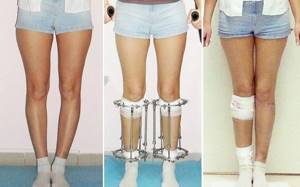
Surgical correction
After installing the wires, an artificial bone fracture is performed - osteotomy. On the 5th day after the operation, the doctor begins to correct the shape of the legs using a device, taking into account existing standards and the wishes of the person. This method is very accurate, it allows you to make your legs perfectly straight. After the device straightens the legs, it is fixed in the correct position for at least a month. At this time, the bones fuse in the desired position. The patient can now move normally with the device on his feet and does not experience pain. When the bones heal, the doctor uses X-rays to see if the bone tissue has healed well. If everything is normal, the device is removed, and the patient is prescribed to perform therapeutic exercises to strengthen the muscles. It is worth noting that recovery occurs faster in those patients who moved during the fixation period.
Complications
The patient's recovery time after surgery is on average 2 months, if no complications arise. An operation to correct the shape of the legs is not as safe as it seems at first glance; it can provoke serious complications:
- Infections in the wound, which force repeated operations and removal of the device. This can occur if the patient has chronic inflammatory processes in the body, any kind, even caries. Therefore, before the operation you need to get tested and cure all inflammations. Poor care of a postoperative wound can also provoke infection.
- Hematomas and swelling that occur when the integrity of blood vessels is disrupted.
- Loss of sensation in the legs due to nerve damage.
- Adverse reactions to anesthesia. To avoid them, it is necessary to make sure that the patient does not have severe disorders of the internal organs, as well as an individual reaction to the drugs.
Surgery to correct crooked legs is a serious and expensive procedure, so the patient needs to think twice before going for it.
It is quite possible that the condition can be improved with simple exercises and diet, and no surgery will be needed at all. Share:
Note:
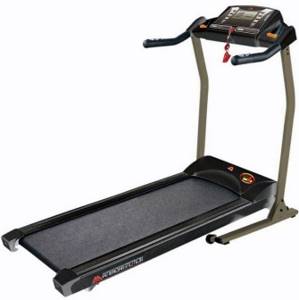
Very often to V.D. Girls turn to Gitt asking him to help him straighten his legs. However, most often the problem is found not in the joint, but in unformed leg muscles and excess fat deposits. You can eliminate this problem by regularly exercising on a treadmill. A large selection of treadmills for any budget in the Stimul store.
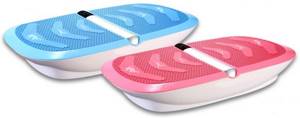
The vibration platform will help prepare the legs of a child and an adult for massage using the V.D. method. Gitta, improve the shape of your legs by creating beautiful muscles. Large selection of home vibration platforms in the Stimul store.
How to straighten crooked legs at home?
Before discussing the topic of how to straighten crooked legs, it is necessary to find out how this occurs. The reason may begin in infancy - during birth, the child receives varying degrees of dislocation of the hip joint or its prenatal underdevelopment. It is much easier to eliminate pathology in childhood, but they resort to it already in adulthood.
You need to understand what types of legs exist, and which are considered curved from a medical point of view:
- Ideal shape. This form provides for free contact of the ankles and knees of the lower extremities in a standing position.
- O-shape. In a standing position, the ankles are defined in a connected state, and the knee joints are located at some distance.
- X-shape. In a standing position, the knee joints are in contact with each other, the ankles are at a certain distance.
- False curvature – when the bones are straight, a curvature is visualized. This condition occurs due to the abnormal development of certain muscles of the lower extremities.
Before prescribing a course of treatment, an orthopedic doctor will certainly conduct a medical examination and identify the optimal methods.
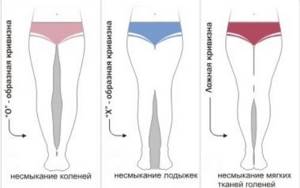
Treatment
It is possible to treat true curvature of the legs conservatively, in which deformation of the joints has occurred, only before the age of 14, while the bones are still growing and forming. But patients are still interested in what to do if they have crooked legs. In adulthood, there are only two options: either undergo surgery to correct the curvature, or hide the defect under clothing.
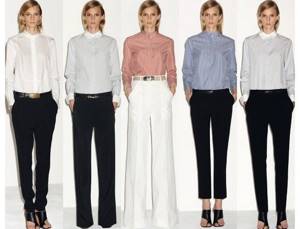
Clothing can help hide crooked legs
Let's look at a few tips on how to hide crooked legs under clothes:
- For girls, there is an easy way to hide crooked legs - long skirts and floor-length dresses. It is not recommended to wear miniskirts and mid-length models, they emphasize the defect.
- If there is leg deformity, it is not recommended to wear tapered trousers, leggings and breeches. In this case, classic wide trousers are good, and striped clothes visually distort already imperfect legs.
- You can also wear capris, but only wide ones at the bottom. But it is worth remembering that capri pants visually shorten your legs, so they are not suitable for short girls and women.
- Pants with vertical stripes strongly emphasize the curvature of the legs, so you should avoid them.
- Girls need to use thick and plain tights; models with bright prints will create unnecessary emphasis on their legs.
- Tall girls with crooked legs are not recommended to wear high-heeled shoes.
In childhood, while the legs are still developing, they can be easily corrected; you just need to consult a specialist in time. The baby will be prescribed to wear orthopedic shoes, take vitamins, perform physical therapy, undergo massage and physical therapy. As a result, the legs will continue to grow correctly and there will be no problems in adulthood. For false curvature of the legs associated with muscle asymmetry and excess weight, conservative treatment is indicated. The patient needs to perform a set of exercises to strengthen the legs, as well as lose excess weight by following proper nutrition. Examples of exercises:
- Run daily at a slow or medium pace for at least 20 minutes;
- Exercises bicycle and scissors;
- Lunges forward and to the side;
- Squats;
- Swing your legs up and to the side;
- Stretching exercises for the muscles of the thighs and lower legs.
Working out in the gym with an instructor is especially effective; he will help you choose a set of effective exercises on the machines. It’s worth noting right away that training must be regular, otherwise there will be no effect. It is also very important to train the whole body, do not forget about the back, arms and buttocks. You should not do exercises on the same muscle group every day; such training is not effective, since the muscles need time to recover.
Correction method
The process of eliminating curvature of the lower extremities has various methods of achieving the goal, built on three main principles:
- The most radical way to solve the described problem is surgical intervention. Correction of leg curvature is achieved surgically using an Ilizarov medical device or through pure surgery. It can have a negative impact on the human body, as various kinds of complications may arise.
- The easiest way is to visually correct the problem. How to straighten crooked legs at home? This technique works best here. It involves wearing the “correct” clothing as usual. For example, if you really want to wear miniskirts, you can hide the curvature of your legs with tights with a large geometric pattern or over the knee boots. For thin legs, it is recommended to wear tights with horizontal stripes or an additional shiny thread in the fabric itself.
Housewives with crooked legs are advised to give preference to trousers with an even cut. And you should forget about skirts above or knee-length and breeches.
- The most time-consuming, but accessible way to achieve a goal is to perform certain physical exercises. With their help, you can correct false curvature of the legs.
Exercise will make your legs slender
Exercise No. 1. You need to sit comfortably on the floor, straightening your lower limbs forward, and lean your hands behind you. Stretch the toe of your right foot forward and then sharply pull it in the opposite direction (towards you). The exercise is performed ten times. Repeat similarly with the second leg. Tip: When performing exercises, it is recommended to spring your lower leg as much as possible.
Exercise No. 2. The position is similar to the previous one. Pull the toe of your right foot towards the floor, and the toe of your left foot towards you. Fix this state for 15 s, then change legs. performed with each leg at least five times.
Exercise No. 3. You need to stand on the toe of your left foot, bend your right foot around the calf muscle. In this position, you need to squat ten times and then change limbs and repeat.
Joint and bone deformities can also lead to bowed lower limbs. In this case, correction without surgery is possible. Yoga classes are recommended here, which requires careful selection of individual exercises. Therefore, you cannot do without seeking help from the appropriate instructor. To achieve the desired result, the duration of attendance at such classes must be at least a month.
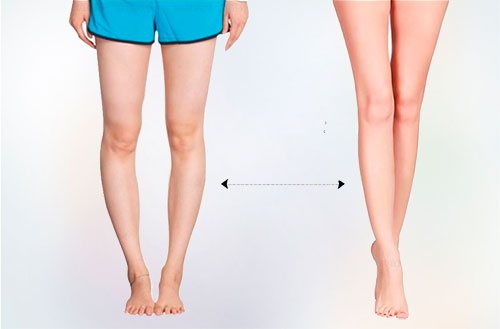
To achieve slimness of your legs, you need to work regularly and remember the need to perform even basic physical exercises.
Only with persistence and desire will you allow, without hesitation, to wear beautiful and stylish women's clothing and not hide your own legs.
Universal complex
Place some gym mats on the floor and get started.
Exercise 1. Swing your arms
- Lie on your back, place a roll of a rolled towel 2-5 cm thick under your shoulder blades (the thickness of the roll depends on your age and height).
- Pick up dumbbells (plastic water bottles): women and teenage children - weighing 0.3 kg, men - up to 2 kg. Extend your arms along your body.
- Swing with straight and slightly tense arms, raising them up and down. The range of movements is maximum.
It is recommended to do 200-300 movements 2 times a day.
When performed regularly, this exercise is very beneficial for the thoracic spine.
Children can do this exercise in its entirety right away, but adults should be careful to gradually increase the load to avoid damaging the shoulder joints.
For arthrosis and arthritis of these joints, the exercise is not recommended.
Exercise 2. Spinal stretch
- Stand up, lower your arms and clasp your hands behind your back.
- Tighten your arms as much as possible, bringing your elbows close together.
- Move your shoulders and head back, arms back and down.
- The chest should bend forward.
- Try to bring your elbows and shoulder blades together, pull your head towards your back. (Do not stand on your toes, do not stick out your stomach.)
- Hold the pose for 1 second.
- Then relax as much as possible, unclasp your arms and pull your stomach in slightly.
- Direct your gaze slightly upward.
- Do not straighten your shoulders and do not take a deep breath - movements should only be made using the abdominal muscles.
The exercise takes no more than 2 seconds and is performed 2 times per hour; during school hours - 2 times every break.
Exercise 3. Snake
- Lie on your stomach. Place your arms bent at the elbows, palms down, near your chest.
- Raise your head and upper chest very slowly, using only your back muscles at first, then gradually straightening your arms.
- Having risen up as much as possible, slowly turn your head first to one side, then to the other.
- Try to look at your heels.
Perform the exercise in the morning and evening 3 times.
Exercise 4: Lower back stretch
- Get on your knees and from this position sit on your heels. Pull your stomach slightly and move forward.
- Then try to lie on your back so that your heels remain under your buttocks.
- Hold this position for a few minutes until pain appears.
Repeat 2-3 times a day.
The exercise is very effective for treating lumbar kyphosis, but is dangerous for advanced arthrosis of the knee joints.
Exercise 5. Relaxation
- Lie on your back, placing a thick cushion 10-15 cm thick under your lower back.
- It is advisable to remain in this position for up to 40 minutes a day, and in severe cases, more. Some mothers place a cushion on their baby when he goes to bed.
Exercise 6. Boat
- Lie on your stomach. Stretch your arms forward.
- Then lift them up as much as possible, simultaneously lifting your head and legs.
- Repeat several times.
The exercise strengthens the back muscles well and is practically safe in terms of displacements and injuries of the intervertebral discs.
